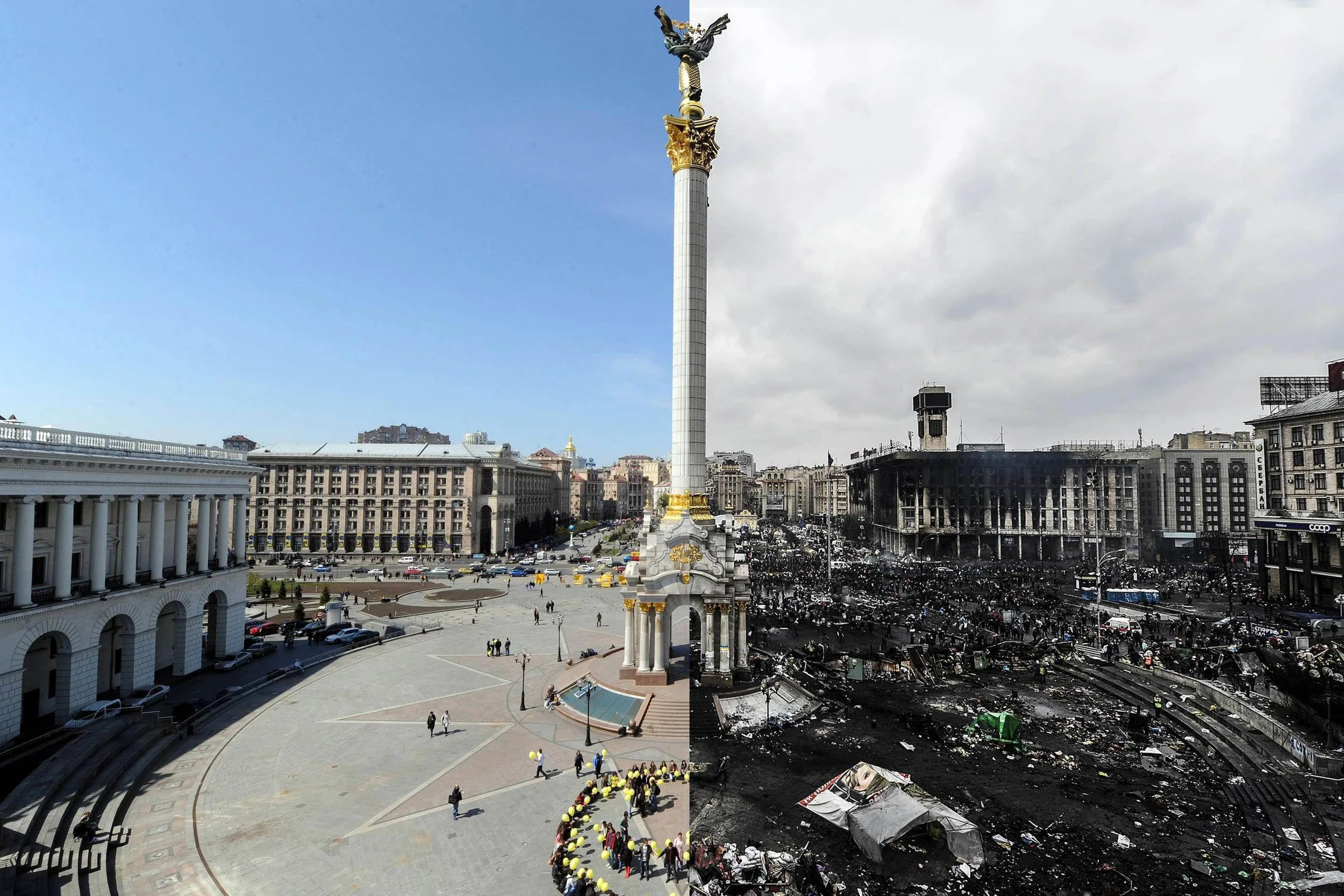Independence Square. Kiev, Ukraine. During a social movement called “Smile Ukraine! Smile overcomes a crisis!” Taken on April 22, 2009 Right: Three months after a political crisis erupted leaving dozens dead. Taken on February 20, 2014. Image source: Sergei Supinsky, Bulent Kilic/AFP/Getty Images via The Atlantic Monthly
Cities are living organisms each harbors unique, dynamic spaces and networks. The development of urban public space is informed by its’ geology, typography, resources, history, culture, and perhaps above all: governance. The physical manifestation of the city and its’ complex nature is ever-evolving, adaptive, and transformative. This adaptivity can prove to be especially potent, as it gives a city the capability to influence the distribution of political and socio-economical power. Public spaces have potential to further the prosperity of inhabitants or to maintain the status quo for those in power.
In the February issue of the Atlantic Monthly, Matt Ford examined the power of assembly in public space and reviewed a correlation between built form and political purposes in authoritarians states.
“Cairo’s layout also made Tahrir Square the perfect place to launch a revolution. Centrally located in Egypt’s largest city, Tahrir sits near the Egyptian parliament, Mubarak’s political party headquarters, the presidential palace, numerous foreign embassies, and hotels filled with international journalists to broadcast footage of the protests for audiences around the world. After Mubarak stepped down, large public squares in other Arab capitals became revolutionary battlegrounds as well.”
In another word, the perfect stage was set for the modern era.
Historically, public places have acted as epicenters of political moments. Aided by social media, the organization of public gatherings have taken on an entirely new dimension. These spaces no longer need to be centrally located; they are sometimes networked throughout a region with multiple nodes — they are interconnected neighborhoods with agent of change. However efficient or inefficient, the Occupy Wall Street movement was an ultimate expression of democracy. The organization of the movement occurred though conversations and consensus. Since the early days of the movement, the weekly public meetings were held at Tompkins Square Park. The movement was horizontal in hierarchy which required public space for assembly. New York City lacks the revolution launch pad that comparable to Tahrir Square in Cairo or Independence Square in Kiev. The search of a home played a pivotal role in defining the Occupy Wall Street movement.
In New York City, municipally owned parks close after dusk. During the summer of 2011, while the Occupy movement was without a home, general assembly was held in a handful of public parks. The movement’s Tactical Committee learned that privately owned public space (POPS) in New York City are not subject to public park curfew. City Planning Commission in 1961 devised a scheme to provide more public park by way of public / private partnership. This zoning laws incentivized developers to provide publicly accessible space by allowing more build-able space. These zoning laws required owner of Zuccotti Park to keep the park open for “passive recreation” twenty-four hours a day. This loophole provided OWS a home and the rest is history.
Public space is the place for myriad of gatherings, political or otherwise. It is indispensable for democracy both as a symbolic gesture and as a viable arena for levée en masse. People design spaces, and spaces facilitate activities of the people. Designers, in turn, are well positioned to be pivotal agents of social change — a role that must have been unimaginable for the designers of Zuccotti Park.
REFERENCES:
“Pre-occupied: The origins and future of Occupy Wall Street” – Mattathias Schwartz, The New Yorker.
“A Dictator’s Guide to Urban Design Ukraine’s Independence Square, and the revolutionary dimensions of public spaces.” Matt Ford, The Atlantic Monthly.
The People’s Library at Occupy Wall Street. Zuccotti Park, New York City. Taken on November 2, Day 47 of Occupy Wall Street. Image source: David Shankbone/Wikimedia Commons.



